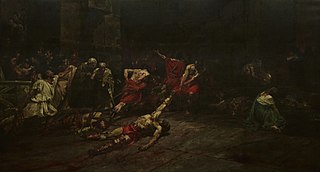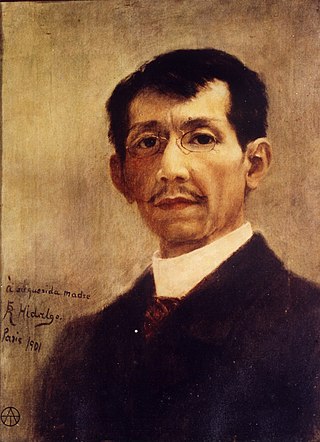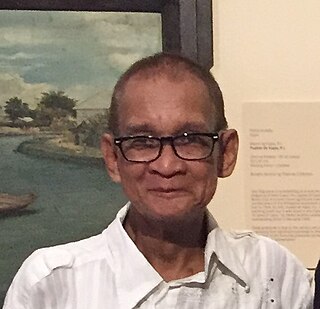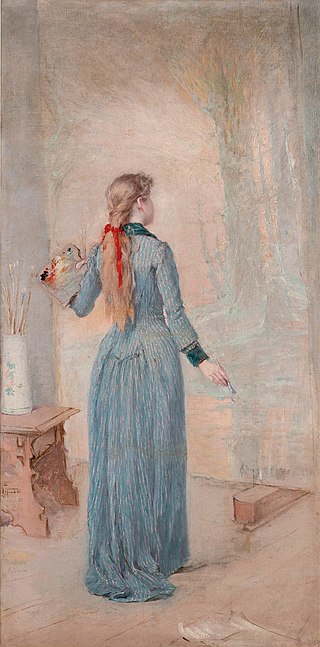Related Research Articles

Juan Luna de San Pedro y Novicio Ancheta was a Filipino painter, sculptor and a political activist of the Philippine Revolution during the late 19th century. He became one of the first recognized Philippine artists.

The Spoliarium is a painting by Filipino painter Juan Luna. Luna, working on canvas, spent eight months completing the painting which depicts dying gladiators. The painting was submitted by Luna to the Exposición Nacional de Bellas Artes in 1884 in Madrid, where it garnered the first gold medal. The picture recreates a despoiling scene in a Roman circus where dead gladiators are stripped of weapons and garments. Together with other works of the Spanish Academy, the Spoliarium was on exhibit in Rome in April 1884.

Fernando Amorsolo y Cueto was a portraitist and painter of rural Philippine landscapes. Nicknamed the "Grand Old Man of Philippine Art," he was the first-ever to be recognized as a National Artist of the Philippines. He was recognized as such for his "pioneering use of impressionistic technique" as well as his skill in the use of lighting and backlighting in his paintings, "significant not only in the development of Philippine art but also in the formation of Filipino notions of self and identity."

Félix Resurrección Hidalgo y Padilla was a Filipino artist. He is acknowledged as one of the greatest Filipino painters of the late 19th century, and is significant in Philippine history for having been an acquaintance and inspiration for members of the Philippine reform movement which included José Rizal, Marcelo del Pilar, Mariano Ponce, and Graciano López Jaena, although he neither involved himself directly in that movement, nor later associated himself with the First Philippine Republic under Emilio Aguinaldo.

Don Fabián de la Rosa y Cueto was a Filipino painter. He was the uncle and mentor to the Philippines' national artist in painting, Fernando Amorsolo, and to his brother Pablo. He is regarded as a "master of genre" in Philippine art.
Fernando Zóbel de Ayala y Montojo Torrontegui, also known as Fernando M. Zóbel, was a Spanish Filipino painter, businessman, art collector and museum founder.
España y Filipinas is a series of oil on wood paintings by Filipino painter, Ilustrado, and revolutionary activist, Juan Luna. It is an allegorical depiction of two women together, one a representation of Spain and the other of the Philippines. The painting, also known as España llevando a la gloria a Filipinas or España Guiando a Filipinas, is regarded as one of the “enduring pieces of legacy” that the Filipinos inherited from Luna.

Las Damas Romanas, also known as The Roman Maidens, The Roman Women, or The Roman Ladies, is an oil on canvas painted in the style of Neo-Classicism by Juan Luna, one of the most famous Filipino painters of the Spanish period in the Philippines. It was painted by Luna when he was a student of the school of painting in the Real Academia de Bellas Artes de San Fernando in Madrid, Spain in 1877. Alejo Valera, a Spanish painting teacher, took Luna as an apprentice and brought him to Rome where Luna created Las Damas Romanas in 1882. Skilled in the style of the Academy he was the first Filipino painter to win international recognition in Europe and the US.

The Death of Cleopatra, also known simply as Cleopatra, is an 1881 oil painting on canvas by the Filipino painter Juan Luna, currently on display at the Museo del Prado in Madrid, Spain. Depicting the death of Cleopatra, the last active ruler of ancient Egypt, the painting was painted during Luna's stay in Rome, and later won a silver medal during the 1881 National Exposition of Fine Arts in Madrid, which was also his first art exposition.

The Blood Compact is an 1886 historical painting by the Filipino painter Juan Luna. It was a gift to the Manila city council.

La Bulaqueña, literally "the woman from Bulacan" or "the Bulacan woman", also sometimes referred to as Una Bulaqueña, is the Spanish title of an 1895 painting by Filipino painter and revolutionary activist Juan Novicio Luna. Bulacan is a province in the Philippines in Luzon island and its residents are called Bulaqueños, also spelled as Bulakenyos in the Filipino language. It is a "serene portrait", of a Filipino woman wearing a María Clara gown, a traditional Filipino dress that is composed of four pieces, namely the camisa, the saya, the pañuelo, and the tapis. The name of the dress is an eponym to María Clara, the mestiza heroine of Filipino hero José Rizal's novel Noli Me Tangere . The woman's clothing in the painting is the reason why the masterpiece is alternately referred to as María Clara. It is one of the few canvases done by Luna illustrating Filipino culture. The painting is displayed at the National Museum of Fine Arts.

The Parisian Life, also known as Interior d'un Cafi, is an oil on canvas impressionist painting made by Filipino painter and revolutionary activist Juan Luna in 1892. The painting presently owned by the Government Service Insurance System is currently exhibited at the National Museum of Fine Arts after the state pension fund transferred management of its collection to the National Museum in March 2012.

The Battle of Lepanto is a painting by Filipino painter and revolutionary activist Juan Luna. Along with Félix Resurrección Hidalgo, Luna is one of the first Filipinos to excel and earn recognition in the international field of arts and culture.

Hymen, oh Hyménée!, also known as Boda Romana, is a painting by Filipino painter Juan Luna. Luna, working on canvas, started in 1886 and later completed in 1887 during the artist's honeymoon in Venice after his wedding to Paz Pardo de Tavera. The painting was submitted by Luna to the Exposition Universelle in 1889 in Paris, France, where it garnered a bronze medal. The picture recreates a scene of a Roman wedding ritual specifically the bride's entrance into the groom's home.
Daphnis and Chloe is a work from the 2nd century AD by the Greek author Longus. This story is the basis of several works of art:

The National Museum of Fine Arts, formerly known as the National Art Gallery, is an art museum in Manila, Philippines. It is located on Padre Burgos Avenue across from the National Museum of Anthropology in the eastern side of Rizal Park. The museum, owned and operated by the National Museum of the Philippines, was founded in 1998 and houses a collection of paintings and sculptures by classical Filipino artists such as Juan Luna, Félix Resurrección Hidalgo and Guillermo Tolentino.
José Honorato Lozano was a Filipino painter born in Manila. He is best known as the pioneering practitioner of the art form known as Letras y figuras, in which the letters of a patron's name is composed primarily by contoured arrangements of human figures surrounded by vignettes of scenes in Manila - an art form that may have derived loosely from illuminated manuscripts. Santiago Pilar, an authority on 19th-century paintings, described Lozano's works as "some of the most quaint and endlessly fascinating relics of Filipino culture in Spanish times".
The Academia de Dibujo y Pintura was an institution for artistic instruction in Manila, Philippines, founded in 1821 by Damián Domingo with the support of the Real Sociedad Economica Filipina de los Amigos del Pais. The academy closed in 1834 but re-opened in 1845 with funds bequeathed by Queen Isabela II. In 1891, the school would become known as the Escuela Superior de Pintura, Escultura y Grabado. While the Academia de Dibujo y Pintura refers distinctly to the institution established in 1821 and re-established in 1845 under the benefaction of the Sociedad Economica de los Amigos del Pais, it is officially considered to be the forerunner of the School of Fine Arts, which is the present-day College of Fine Arts of the University of the Philippines.

Santiago Albano Pilar more popularly known as Jak Pilar, was a Filipino art historian, curator, and author. He was best known for chronicling Philippine art centered on the 19th and the 20th century in numerous publications in both the Philippines and overseas.

The La Pintura is a painting by the Filipino artist Félix Resurrección Hidalgo done in the style of Impressionism. The painting depicts a woman holding an paintbrush while turning back to the viewer, as she gazes towards an unfinished canvas. Hidalgo's La Pintura was subsequently sold for a world record of the artist of PHP78.256 million at a Salcedo Auctions' Important Philippine Art sale in the Philippines on September 21, 2019.
References
- ↑ "Daphne y Cleo" by Juan Luna, lopezmuseum.org.ph Archived January 29, 2010, at the Wayback Machine
- ↑ "Philippine Heroes – Juan Luna y Novicio (1857–1899)" [usurped] , Etravel Pilipinas
- ↑ "Mad or Genius? 7 of Juan Luna's Most Intriguing Works and Their Meaning".
- ↑ "Juan Luna's long-lost masterpiece finally resurfaced; telling us about his marital life and artistic excellence".
